Because it's too dangerous to retrieve the hundreds of dead bodies on Mount Everest's icy slopes, most climbers remain right where they fell when they were trying to summit Earth's tallest peak.
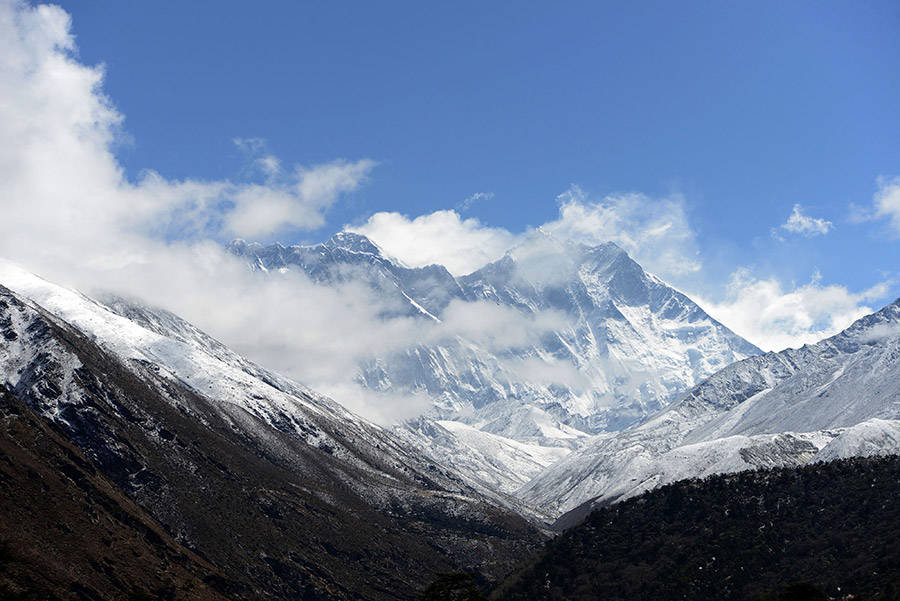
PRAKASH MATHEMA/Stringer/Getty ImagesThere are some 200 dead bodies on Mount Everest, serving as grim warnings for other climbers to this day.
Mount Everest holds the impressive title of tallest mountain in the world, but many people don’t know about its other, more gruesome title: the world’s largest open-air graveyard.
Since 1953, when Edmund Hillary and Tenzing Norgay scaled the summit for the first time, more than 4,000 people have followed in their footsteps, braving the harsh climate and dangerous terrain for a few moments of glory. Some of them, however, never left the mountain, leaving hundreds of dead bodies on Mount Everest.
- How Many Dead Bodies Are On Mount Everest?
- The Tragic Tales Behind Some Of The Most Infamous Mount Everest Bodies
How Many Dead Bodies Are On Mount Everest?
To date, it’s estimated that more than 340 people have died climbing Earth’s tallest mountain and that there are approximately 200 dead bodies on Mount Everest to this day.
Why Are The Bodies On Mount Everest Left There?
The things that make Mount Everest dangerous to climb are the same things that make it difficult to retrieve dead bodies that have fallen there.
When someone dies on Everest, especially in the death zone, it is almost impossible to retrieve the body. The weather conditions, the terrain, and the lack of oxygen makes it difficult – and expensive – to get to the bodies. Even if they can be found, they are usually stuck to the ground, frozen in place.
Do Bodies Decompose On Mount Everest?
Bodies left on Mount Everest tend to be extremely well preserved due to the consistently below-zero temperatures and low oxygen levels. In fact, the corpses and their gear can often remain just as they were when they first hit the snow for decades afterward.
The Financial And Ethical Implications Of Retrieving Everest Bodies
Though many surviving family members of deceased Everest climbers as well as officials and passersby on the mountain feel an ethical calling to retrieve the bodies and repatriate the remains, there is another ethical concern that goes against this impulse. The fact is that retrieving these bodies is extremely dangerous for the people assigned to do so, thus there is an ethical imperative to spare recovery personnel from a mission that has a high likelihood of death or serious injury.
Meanwhile, the costs of retrieving a body can be extremely high. Between personnel and gear, these costs will easily be in the tens of thousands of dollars, sometimes surpassing $100,000.
Rainbow Valley: Everest’s Open Graveyard
The top portion of the mountain, roughly everything above 26,000 feet, is known as the “death zone.” Within the death zone is a section called “Rainbow Valley” after the multi-colored jackets of the numerous dead climbers who remain on Everest.
In the death zone, oxygen levels are only at a third of what they are at sea level, and the barometric pressure causes weight to feel ten times heavier. The combination of the two makes climbers feel sluggish, disoriented and fatigued and can cause extreme distress on organs. For this reason, climbers don’t usually last more than 48 hours in this area.
The climbers that do are usually left with lingering effects. The ones that aren’t so lucky and die on Mount Everest are often left right where they fell.
Below are the stories behind just some of the bodies on Mount Everest that have accumulated over the years.
The Tragic Tales Behind Some Of The Most Infamous Mount Everest Bodies
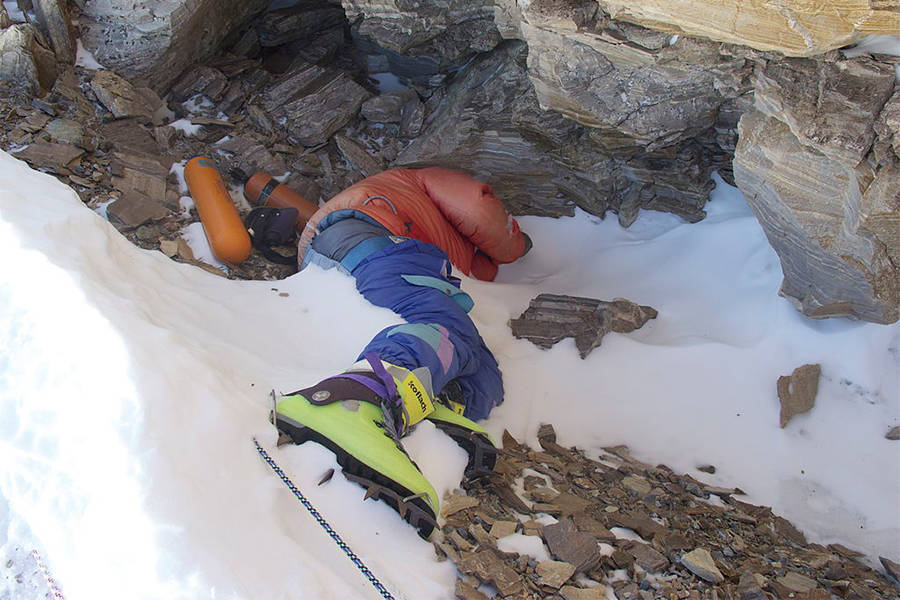
Wikimedia CommonsThe corpse of “Green Boots,” widely thought to be Tsewang Paljor, is one of the most infamous dead bodies on Everest.
Standard protocol on Mount Everest is just to leave the dead right where they died, and so these Mount Everest bodies remain there to spend eternity on its slopes, serving as both a warning to other climbers as well as gruesome mile markers.
The Mystery Behind The Fallen Everest Climber Known Only As “Green Boots”
One of the most famous Mount Everest bodies, known as “Green Boots” was passed by almost every climber to reach the death zone. The identity of Green Boots is highly contested, but it is most widely believed that it is Tsewang Paljor, an Indian climber who died in 1996.
Before the body’s recent removal, Green Boots’ body rested near a cave that all climbers must pass on their way to the peak. The body became a grim landmark used to gauge how close one is to the summit. He is famous for his green boots, and because, according to one seasoned adventurer “about 80% of people also take a rest at the shelter where Green Boots is, and it’s hard to miss the person lying there.”
Francys Arsentiev: The “Sleeping Beauty” Of Mount Everest
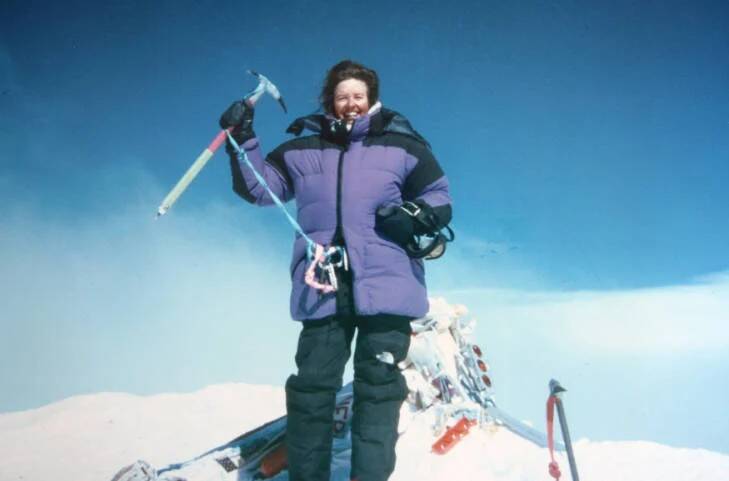
Denver Public LibraryBelieved to be the last photo of her alive, Francys Arsentiev stands at the peak of Mount Everest.
Francys Arsentiev made history on May 22, 1998 when she became the first American woman to reach the top of Mount Everest without the aid of supplemental oxygen. Unfortunately, that is not the only reason Arsentiev became a notable figure in Everest’s history.
Arsentiev would never make it down the mountain. Her body remained on Mount Everest for the next seven years and became known as the “sleeping beauty” of the mountain. Because Arsentiev and her husband, experienced climber Sergei Arsentiev, decided against using supplemental oxygen to aid their journey up the mountain, the couple had to travel slowly in the 20,000 foot peak.
This meant they stayed in the dangerously low-oxygen region for a long time. So long, that they likely began to feel disoriented and fatigued. While making their way down the mountain, the couple got separated, leaving Francys Arsentiev was lost and alone.
Another climbing couple, Ian Woodall and Cathy O’Dowd, came across a disoriented and frost-bitten Francys Arsentiev. They tried to help her, but conditions on the mountain worsened. Fearing for their own safety, Woodall and O’Dowd had to leave the woman in the snow.
Arsentiev’s frozen body looked smooth and hard thanks to the frostbite, leading O’Dowd to compare the woman to sleeping beauty, a nickname the headlines loved. Sergei Arsentiev’s body was discovered one year later.
The 1996 Everest Disaster That Killed Experienced Climbers Rob Hall And Scott Fischer
In May 1996, a group headed for a climbing expedition of Mount Everest. Rob Hall, a guide and experienced mountaineer led the expedition, one only a few would return from.
Hall had summited the famous mountain numerous times before through a company he had started with his friend Gary Ball, Adventure Consultants. However, Hall knew the perils of climbing all too well. In 1993, Ball died of a cerebral edema while climbing the Himalayas with Hall. Hall was forced to his friend on the mountainside.
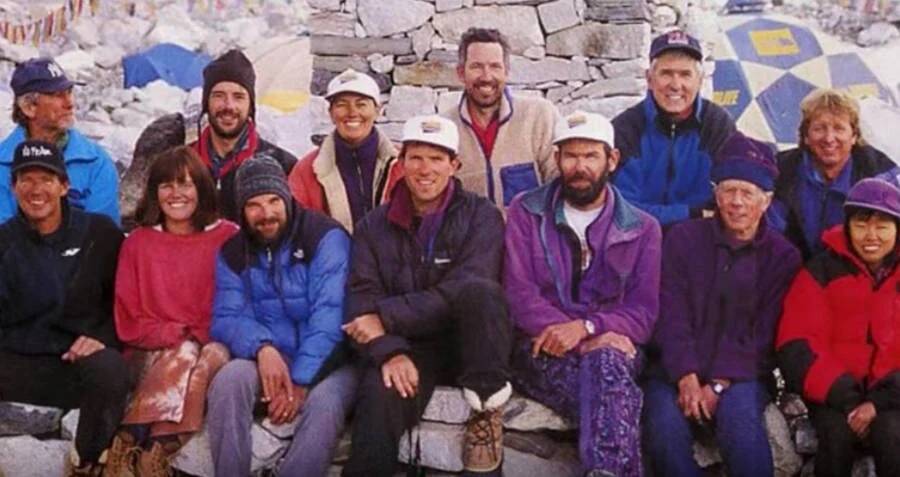
YouTubeRob Hall and the crew that embarked on the May 1996 expedition.
The expedition in May 1996 was supposed to be routine. The group consisted of three guides and eight clients, including journalist Jon Krakauer who was going to be covering the trip in a magazine.
As the group approached the summit, they met up with other climbing expedition, one of which was led by Scott Fischer, another well-experienced mountaineer. However, as the group began to descend a blizzard hit.
Twelve hours after the blizzard, the regulator of Hall’s oxygen mask was frozen and was unable to provide him with air. A few hours later, his hands and feet were frostbitten. He was able to speak to his wife one more time with his satellite phone.
Neither Hall nor Fischer survived the trek, but some of their crew did. The journalist, Krakauer, survived and published the story of the disaster in Outside magazine. Hall’s body remains on the mountain to this day, a stark reminder that experience isn’t guaranteed safety on Mount Everest.
The Tragic Everest Death Of Shriya Shah-Klorfine
May 19, 2012, Shriya Shah-Klorfine embarked on making her childhood dream a realty. She reportedly paid a climbing tourism company, Utmost Adventure Trekking, almost $40,000 to reach the summit.
Shah-Klorfine had very limited climbing experience. Utmost claimed they would teach her everything she needed to know to complete the climb, however the startup had never made the climb before. However, Shah-Klorfine struggled in the training, and the company’s senior Sherpa guide told her she shouldn’t attempt the climb.
She decided to go forward anyways — and the company let her.
Shah-Klorfine began her climb on May 18. On her way to the summit, a different Sherpa on his way down the mountain tried to convince her to turn around, as she didn’t have enough oxygen to complete the climb. Despite the warning, she continued to the peak.
She did make it to the top of the mountain, however, she did not have enough supplemental oxygen to make it to the bottom. After 27 hours of climbing, Shah-Klorfine died on May 19, 2012. Her body was discovered by climber Leanne Shuttleworth the next day.
Shah-Klorfine’s body was removed from the side of the mountain ten days later by helicopter.
David Sharp And His Harrowing Death On Mount Everest
In 2006 another climber joined Green Boots in his cave and became one of the most infamous Mount Everest bodies in history.
David Sharp was attempting to summit Everest on his own, a feat which even the most advanced climbers would warn against. He had stopped to rest in Green Boots’ cave, as so many had done before him. Over the course of several hours, he froze to death, his body stuck in a huddled position, just feet from one of the most well-known Mount Everest bodies.
Unlike Green Boots, however, who had likely gone unnoticed during his death due to the small amount of people hiking at that time, at least 40 people passed by Sharp that day. Not one of them stopped.
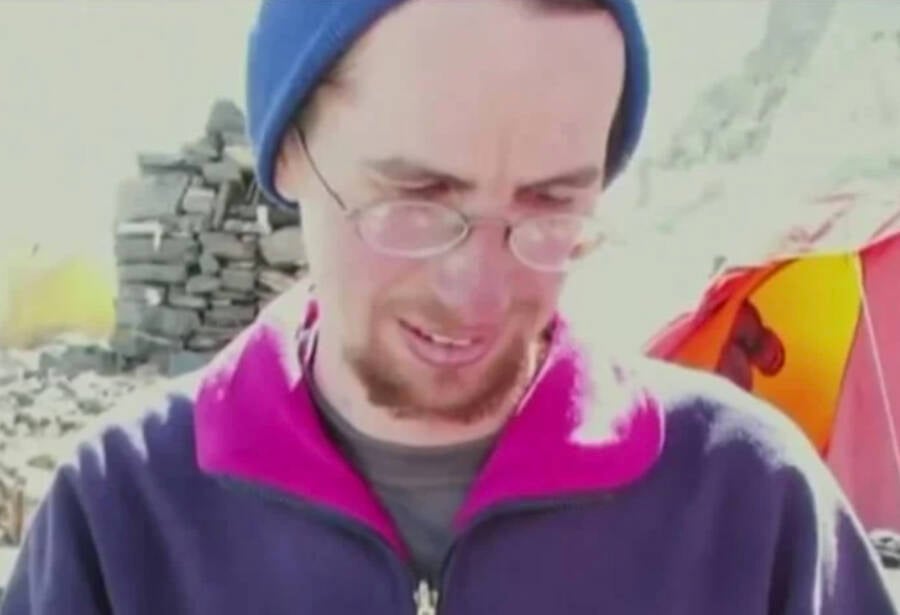
YouTubeDavid Sharp preparing for the fateful climb that would ultimately turn him into one of the most famous dead bodies on Mount Everest.
Sharpe’s death sparked a moral debate about the culture of Everest climbers. Though many had passed by Sharp as he lay dying, and their eyewitness accounts claim he was visibly alive and in distress, no one offered their help.
Sir Edmund Hillary, the first man to ever summit the mountain, alongside Tenzing Norgay, criticized the climbers who had passed by Sharp and attributed it to the mind-numbing desire to reach the top.
“If you have someone who is in great need and you are still strong and energetic, then you have a duty, really, to give all you can to get the man down and getting to the summit becomes very secondary,” he told the New Zealand Herald, after news of Sharp’s death broke.
“I think the whole attitude towards climbing Mt Everest has become rather horrifying,” he added. “The people just want to get to the top. They don’t give a damn for anybody else who may be in distress and it doesn’t impress me at all that they leave someone lying under a rock to die.”
The media termed this phenomenon “summit fever,” and it’s happened more times than most people realize.
How George Mallory Became The First Dead Body On Mount Everest
In 1999, the oldest known body to ever fall on Mount Everest was found.
George Mallory’s body was found 75 years after his 1924 death after an unusually warm spring. Mallory had attempted to be the first person to climb Everest, though he had disappeared before anyone found out if he had achieved his goal.
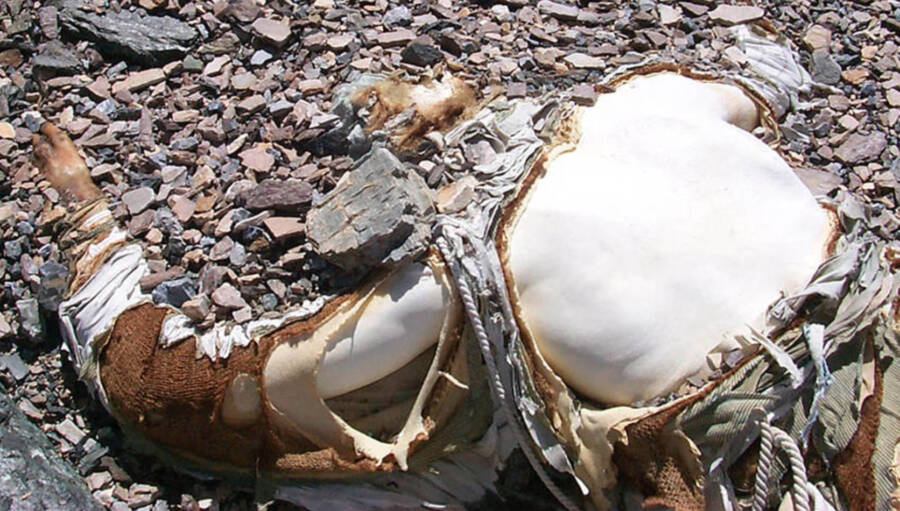
Dave Hahn/Getty ImagesThe corpse of George Mallory, the first body on Mount Everest to ever fall on its treacherous slopes.
His body was found in 1999, his upper torso, half of his legs, and his left arm almost perfectly preserved. He was dressed in a tweed suit and surrounded by primitive climbing equipment and heavy oxygen bottles. A rope injury around his waist led those who found him to believe he had been roped to another climber when he fell from the side of a cliff.
It is still unknown whether Mallory made it to the top, though of course the title of “the first man to climb Everest” has been attributed elsewhere. Though he may not have made it, rumors of Mallory’s climb had swirled for years.
He was a famous mountaineer at the time and when asked why he wanted to climb the then-unconquered mountain, he famously replied: “Because it’s there.”
The Sad Demise Of Hannelore Schmatz In Everest’s Death Zone
One of the most horrifying sights on Mount Everest is the body of Hannelore Schmatz. In 1979, Schmatz became not only the first German citizen to perish on the mountain but also the first woman.
Schmatz had actually reached her goal of summiting the mountain, before ultimately succumbing to exhaustion on the way down. Despite her Sherpa’s warning, she set up camp within the death zone.
She managed to survive a snowstorm hitting overnight, and made it almost the rest of the way down to camp before a lack of oxygen and frostbite resulted in her giving into exhaustion. She was only 330 feet from base camp.
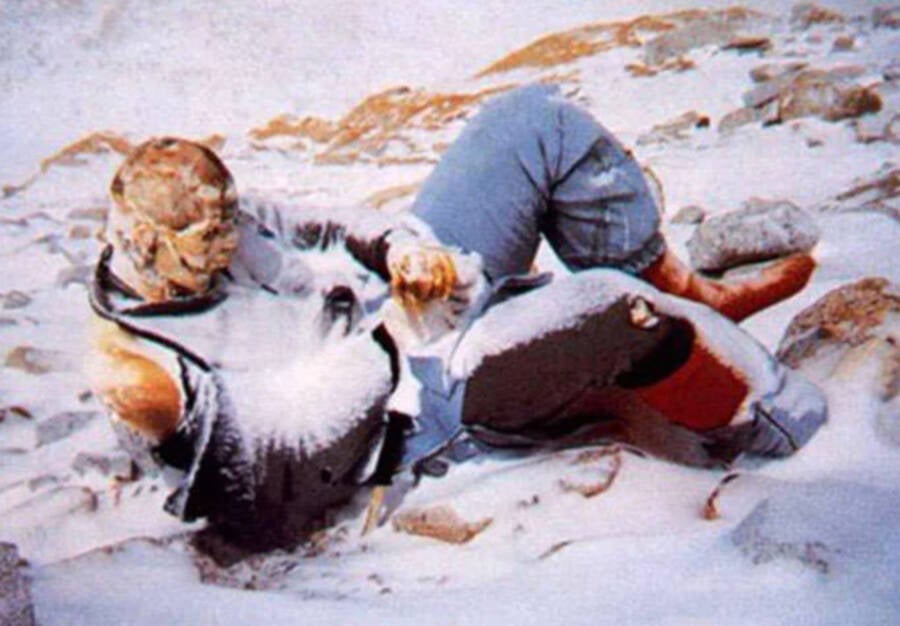
YouTubeAs the first woman to die on Earth’s tallest mountain, Hannelore Schmatz’s corpse became one of the most famous dead bodies on Mount Everest.
Her body remains on the mountain. It was in plain view of the mountain’s Southern Route, leaning against a long deteriorated backpack with her eyes open and her hair blowing in the wind until the 70-80 MPH winds either blew a covering of snow over her or pushed her off the mountain. Her final resting place is unknown.
Two rescuers died while trying to recover Schmatz’s body and countless others have perished while trying to reach the rest.
Despite the risks, and the bodies they will encounter, thousands of people flock to Everest every year to attempt this impressive feat. And while it isn’t even known for sure how many bodies are on Mount Everest today, these corpses have done nothing to dissuade other climbers. And some of those brave mountaineers are sadly destined to join the bodies on Mount Everest themselves.
How many dead bodies are there on Mount Everest?
It’s estimated that there are more than 200 bodies left on Mount Everest. Due to the mountain’s hazardous conditions, the exact number of bodies still on the mountain is unknown.
How many people have died on Mount Everest?
More than 340 people have died while climbing Mount Everest.
Why are the bodies on Mount Everest left behind?
The high altitudes and extreme, unpredictable conditions make it difficult to remove bodies from the mountain. Additionally, frozen bodies are heavy, often weighing more than 300 pounds each. Meanwhile, helicopters cannot fly over a certain altitude, adding to the struggle to get bodies off of the mountain.
What’s more, it’s very expensive to retrieve these bodies, with costs sometimes reaching $70,000.
Are there any efforts to create memorials or proper burials for these climbers?
Yes, there are a number of memorials located at Everest Base Camp dedicated to those who have lost their lives on the mountain.
Have any climbers survived being left for dead on Everest?
Yes, one of the most well-known cases of this is climber Lincoln Hall, who narrowly survived after spending the night at 28,543 feet during his descent from the mountain.
What are the rules or traditions regarding taking photos of dead climbers?
Many climbers who have died on Everest — including Green Boots, Hannelore Schmatz, and George Mallory — have had their corpses photographed. Without any hard rules governing the taking of such photos, some images are captured for their news value and historical importance, while other climbers feel it’s more respectful to abstain from this.
Has climate change affected the visibility of dead bodies on Everest?
Melting ice caused by climate change has indeed revealed bodies on Mount Everest that weren’t visible before. Five bodies, for instance, were retrieved in 2024 after being revealed by melting ice and snow. In the words of Aditya Karki, a major in Nepal’s army who led the expedition, “Because of the effects of global warming, (the bodies and trash) are becoming more visible as the snow cover thins.”
Do Everest expedition companies warn clients about the presence of dead bodies?
Public literature available from Everest expedition companies generally doesn’t expound upon the bodies scattered on the mountain, and instead focuses on other aspects of preparation for the climb, such as physical training.
How are the identities of newly discovered bodies determined?
Where applicable, DNA as well as documents found on the body can help identify the deceased. However, in many cases, retrieving such things is impossible and the fallen climber remains unidentified.
What are some of the most famous dead bodies left on Mount Everest?
A number of dead bodies on Mount Everest have become especially well known due to the stories behind them or the photos of their corpses that have circulated in the media.
These include Francys Arsentiev, known as “Sleeping Beauty” because of the way she died lying on her side in 1998, and Hannelore Schmatz, who perished in 1979 and became the first woman to ever die on Everest’s upper slopes.
Other notorious corpses include “Green Boots,” known for his distinctive footwear, and George Mallory, who may have been the first person to summit the mountain just before dying there in 1924, leaving his body undiscovered until 1999.
Enjoy this article on the dead bodies on Mount Everest? Next, read the incredible Everest survival story of Beck Weathers. Then, learn about the demise of doomed snowboarder Marco Siffredi on Everest.





